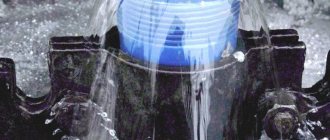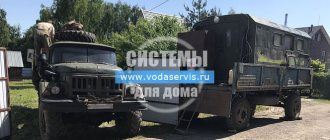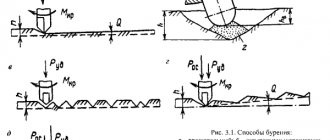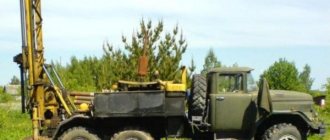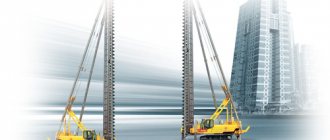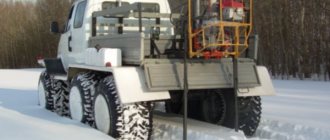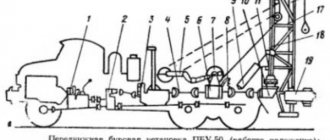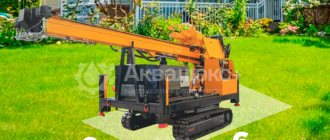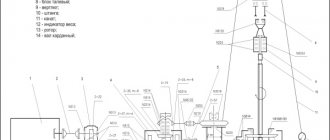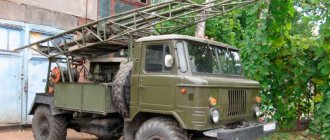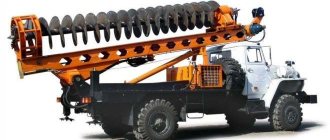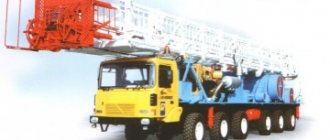Wherever the house or dacha is located, access to clean water is one of the basic conditions for an organized home life. A drilling rig for drilling water wells helps you get constant access to drinking water. Let's figure out what mechanisms will help solve this large-scale problem, what features and application possibilities they have.
Water on the site is the key to comfortable living Source mdsg.ru
Pros of professional and homemade drilling rigs
Often the only source of water for a private household is a well, and the level of the aquifer can be located at a depth of 50-100 meters or more. A specialized mechanism will help you get to this depth.
Large-sized drilling equipment, capable of not only drilling water wells, but also carrying out engineering and geological surveys, is rarely used in built-up areas. It is difficult or impossible for such rigs to enter the territory, so the only option is to use small-sized drilling rigs.
Professional small-sized drilling rigs for wells (MGDU) are universal units that allow you to perform drilling operations of different types and in different ways (including drilling an artesian well). The use of MGBU on private plots has the following advantages:
- Drilling operations can be carried out where large equipment cannot pass.
- Thanks to the use of electricity, the cost of work is reduced.
Minimal damage will be caused to the site Source santex-mir.ru
- Small dimensions allow you to preserve the surrounding area in its original form; minimal damage is caused to the soil.
Professional mechanisms work quickly and efficiently, but their use is not always justified, and the cost of services is prohibitive for many farms. For industrially manufactured units, there is an alternative: homemade devices that can cope with drilling efficiently.
Of course, you should not purchase or build such equipment for one single use. But it makes sense to gain experience, which can then become a source of stable income. Drilling is a process that is in demand not only for water supply, but also, for example, during the construction of foundations.
Homemade units have a small power, which is not enough to drill an artesian well, the average depth of which starts from 100-150 m. But their resources are enough to make a well of average depth (20-40 m).
MGBU helps organize water supply for a private home Source par-torg.com
Homemade installations for drilling water wells are actively used in private households for the following reasons:
- Compact dimensions and low weight make the unit easy to transport and install. To relocate to a new location, you will not need to look for special equipment for transportation.
- Easy assembly/disassembly, simple operation. During operation, a home-made installation, like a professional one, can be connected to an electrical network or to an alternative source, which ensures quick completion of the work.
- A well can be drilled in a confined space (basement, garage) if the ceiling height exceeds 2 m.
Manufacturers and popular models
Large-scale production of installations is established in factories in Europe and the USA, but there are also high-quality HDD installations from Chinese and domestic manufacturers.
Vermeer
The American company Vermeer and its representative offices in Europe produce drilling equipment that is a real standard of quality. Wermer products are universal: they are used for laying all types of underground pipeline routes and have a wide range of capacities and sizes. Among them, the most applicable are Series II units, which work with the heaviest soils.
| Indicators | Navigator D7x11 Series II | Navigator D36x50 Series II | Navigator D80x100 Series II | Navigator D330x500 |
| Total weight, t | 4,835 | 8,981 | 17,010 | 40,823 |
| Torque, N.m | 1763 | 6772 | 13558 | 67800 |
| Max drilling expansion diameter, mm | 300 | 800 | 1000 | 1500 |
| Max drilling length, m | 110 | 400 | 800 | 1600 |
| Traction force, t | 4,082 | 16,329 | 36,287 | 149,685 |
The video shows the Vermeer Navigator D7x11 drilling rig:
Sany Heavy Industry CO
Sany is China's largest manufacturer of drilling equipment. His machines are colossal, high-power special equipment capable of working with soil of all categories in any weather conditions.
| Indicators | Sony SD6020 | Sany SD7535 | Sany SD12065 |
| Total weight, t | 9,6 | 17,5 | 25,0 |
| Torque, kN.m | 7100 | 20000 | 33750 |
| Max. drilling diameter, mm | 1500 | 2000 | 2300 |
| Traction force, t | 20,0 | 50,0 | 65,0 |
Ditch Witch
Ditch Witch horizontal drilling rigs have no analogues in the world. The company was one of the first to engage in trenchless communication technologies, and today its products provide convenience, high performance and safety of use. Drilling rigs are produced mainly of medium weight class (midi).
| Indicators | JT5 | JT1220 Mach1 | JT25 | JT30 All Terrain |
| Total weight, t | 1,674 | 4,400 | 9,163 | 8,010 |
| Torque, kN.m | 746 | 1900 | 5420 | 1080 |
| Max. expansion diameter, mm | 114 | from 114 | from 114 | from 140 |
| Rotation speed, rpm | 195 | 180 | 220 | 400 |
Video review of the Ditch Witch horizontal directional drilling installation
MEMPEX
MEMPEX is a Belarusian manufacturer of drilling equipment, one of the pioneers of trenchless drilling. Produces installations of all weight classes, from “mini” to “maxi”.
| Indicators | UNB-20 | MNB-50 | MNB-125 |
| Total weight, t | 0,820 | 1,100 | 3,800 |
| Max. expansion diameter, mm | 300 | 500 | 1000 |
| Max. drilling depth, m | 60 | 120 | 150 |
| Traction force, t | 20,0 | 50,0 | 125,0 |
The video shows the operating principle of HDD installation using the example of the UBN-20 model:
Characteristics of installations and types of wells
Professional and home-made MGDUs are endowed with different technical capabilities and parameters (drilling speed and power). They are designed to produce wells of a certain depth with specified ones. Most well drilling rigs have the following features:
- In the production of drilling equipment, durable alloys and alloy steels are used that are well resistant to wear during operation.
Drilling a well in a dacha Source bani-nsk.ru
See also: Catalog of companies that specialize in engineering systems (heating, water supply, sewerage and others) and related work
- The most compact and convenient is hydraulic equipment for drilling wells. The pressure necessary to rotate the drill is provided by a diesel engine and an oil pump connected to it.
- There are several drilling methods, which are implemented in both professional and homemade mechanisms. The following methods are available: auger, pneumatic impact, with rock washing, rotary, core.
- Hydraulic equipment is capable of destroying the hardest rocks and rocky soils. Drilling can be either vertical or inclined.
- The use of most mechanisms is seasonal: they choose the warm season for work.
- Wells are organized in two ways: rotational or impact. The first method allows you to quickly remove soil from the working area, the second is used less and less, since it requires excessive labor costs at a low speed of work.
- The main disadvantage of MGDU is vibration during the drilling process. It forces a reduction in the speed of work and increases wear on loaded equipment components.
Use of small-sized portable equipment Source bur56.ru
Small-sized installations for drilling wells under water are designed to perform two types of wells:
- Drilling into sand (sand well). The fastest and cheapest way to reach the aquifer. Used when the water is at minimal depths (sometimes 5-10 m). Such a well is designed for only 10-20 years of operation, but it can be drilled using a manual installation.
- Excavation into limestone (artesian well). The depth sometimes reaches 250-300 m; Not only geological surveys may be required, but also permission (licensing) from authorities. The work will cost a significant amount due to its labor intensity, but you will be able to use clean artesian water for more than 50 years.
Different models of MGBU have their own limit for penetration into the ground. On average, it does not exceed 100 m, and to perform ultra-deep excavations, a more powerful well drilling rig will be needed. Homemade mechanisms are limited to a depth of 30-40 m (wells from 40 m are classified as deep).
Using different types of aquifers Source dearhouse.ru
You should know that the same mechanism provides different production depths depending on the chosen technology. For example, if the drilling depth with flushing is 200 m, with blowing - 150 m, with an auger - 30 m.
SBU type machines
At mining enterprises where it is necessary to obtain a material with a more uniform fractional composition after the explosion and without over-grinding, for example in crushed stone quarries, a dense blasting grid is used with smaller hole diameters - from 105 to 160 mm. The most productive drilling on hard rocks, for example granites, of this diameter is carried out using SBU type machines. These machines are widely in demand when drilling hard-to-reach areas, when working in difficult mining and geological conditions, and on cramped work sites.
The physics of the rotary percussion drilling process is similar to roller drilling. The difference is in the method of creating force on the working tool. The SBU bit is equipped with carbide teeth with a spherical working surface, which are embedded in the rock under the impact force transmitted to the bit by a down-the-hole hammer or hydraulic hammer through the drill string. In this case, the rotator of the drilling rig continuously rotates the drill rod, thereby ensuring dispersed penetration of the teeth over the entire surface of the well bottom. When the teeth are introduced into the destroyed rock layer, maximum shear stresses arise; flakes break off around the teeth, which are removed from the well with compressed air.
The body of bits for rotary impact drilling consists of a head and a shank, made solid. The shape of the heads can be blade or pin (with a continuous face surface covered with teeth). There are also different methods of blowing - central, eccentric and external. Chisels can be multi-edged, their durability is higher than single-edged chisels. The K-105K blade chisel has a recess in the central part. When drilling, a core is formed in the center, which is then destroyed by a pin located between the four blades. At the same time, the energy intensity of drilling decreases, and the drilling speed increases.
For many years, machine tools of the SBU-100G-35 model from the Kyshtym Machine Plant have been successfully operated in quarries. This model is equipped with a caterpillar drive and consists of the following components: a working body, hinged in the front part of the machine, including a feed pneumatic cylinder equipped with guides along which the rotator moves. The pneumatic piston feed mechanism includes a fixed cylinder and a movable rod connected to the rotator plate.
The rotator consists of a 4 kW asynchronous motor and a planetary two-stage gearbox. The caterpillar drive consists of two carts with an individual drive for each caterpillar. The drive is an asynchronous motor and a worm gearbox with a braking device. The power source of the machines is a compressor station and a 380 V electrical network. Modifications of the machine: SBU-100N-35 - on a skid, SBU-100P-35 - on a passive pneumatic wheel. At one time, new models were created on the basis of the machine - SBU-100G-50 and 2SBU-100N-32.
The more powerful SBU-125A-32 already includes a chain feed system, a mast (rod length more than 4 m) and a cassette device for mechanized assembly and disassembly of the drill string. The rotator consists of a two-speed electric motor and a planetary gearbox. Crawler drive with individual drive for each caterpillar.
Down-the-hole hammers are a cylinder with a piston-impactor, with a valveless system. Moving in the cylinder, the piston itself blocks the compressed air circulation windows, making oscillatory movements and striking the shank of the drill bit. On modern machines, hydraulic hammers are widely used, which are installed on the machine itself together with a hydraulic rotator, and the impacts on the bit are transmitted through the entire drill string. However, this scheme is effective at shallow drilling depths, since the impact energy is lost during its passage through the drill string.
Drilling technologies
Commercial drilling rigs are designed to use several technologies. The well is obtained in one of the following ways:
- Percussion. The mechanism is fixed on a simple device, a triangular frame; A flexible cable with a chisel and bailer is fixed on top.
- Using a screw tool. Suitable for shallow (up to 20 m) depths, the soil is removed using an auger (rod with a helical surface).
- Rotary (rotary). The fastest and most affordable method is carried out by powerful hydraulic units.
- Hydro drilling. It is carried out with washing of the working area.
- Using a core tool. The rock is destroyed not along the entire cross-section of the face, but along the ring. It is used when drilling hard rocks (for example, granite), not crushed rock, but cores are removed from the working area.
The crushed soil is partially removed to the surface Source yandex.net
Machines with cutting tools
The drilling speed, and accordingly the productivity of the drilling rig, depends on the properties of the rock to be destroyed under the influence of the drilling tool, on the type of drilling, and on the design of the drilling tool. On relatively weak rocks, machines with cutter drilling tools are successfully used. The chips are separated with significant axial force by cutters mounted on the drill bit. When the rod rotates through a screw winding of the auger, the rock is removed from the well. When using a smooth rod, fines are removed with compressed air.
SBR-160A-24 machines manufactured by Karpinsky Machine-Building Plant OJSC and the earlier SVB-2M machines are traditionally widely used in CIS quarries. These are tracked vehicles with electric drive. A welded frame rests on the crawler carriage; the frame contains an oil station, control cabinets, a mast with guides for moving the drill string and rotator, cassettes for storing augers, screwing-unscrewing mechanisms, and feeding the drill string. The machine is also equipped with hydraulic cylinders for machine leveling and mast lifting, a compressor station, hydraulic and pneumatic systems, and an electrical part. Compared to outdated SVB-2M rigs, the SBR-160A-24 rig has an increased mast height, mechanized labor-intensive operations for assembling and disassembling the drill string, increased power of the drives of the main mechanisms, a hydraulic drive for raising and lowering the mast, a more spacious engine room, a heated cabin, etc. Based on the SBR-160A-24, the SBR-160B-32 was created with an increased drilling depth. The Kyshtym Machine Plant offers a more powerful and versatile machine SBR-200-32, which can also drill with roller bits (diameter 160 mm), for which it is necessary to use a trailed compressor.
The cutting bits of drilling tools differ in the number of feathers (blades), the method of their attachment, the shape of the cutting edge, and the location of the cutters on the crown. Crowns can be with either solid feathers or with removable incisors. Typically, crowns with a continuous cutting edge are used on rocks with a hardness of up to f=4 on the Protodyakonov scale. Step-shaped cutting bits equipped with cutters are designed for drilling rocks with a hardness of f<6 and containing strong abrasive layers with a hardness of f=6...8. Two incisors are attached to each feather (two feathers in total), and a two-feather notch is attached to the threaded connection in the central part. The three-flute bit already includes three cutters of different configurations on each blade and is used for drilling low-abrasive rocks with a hardness of f≤8. Four-flute bits and bits with a circular arrangement of cutters have a high coefficient of well overlap and are recommended for use with blowing the well with compressed air. This tool is used when drilling fractured low-formation rocks with a hardness of f≤8.
To achieve optimal drilling parameters, the type of bit is selected separately, the rotation speed is adjusted (if the design of the rotator drive allows) and the feed force. There is a whole family of commercially produced drill bits for use on SBR type drilling rigs.
Drilling rocks with a hardness of f>6...8 using rotary drilling rigs with cutter bits is ineffective: the wear of the cutters increases significantly, there is strong vibration of the drill bit, and the drilling speed is low. For hard rocks, roller-cone drilling is more effective. The tricone bit is fed to the bottom under a large axial force (up to 30 tf with a drilling diameter of 250 mm). The cutters are equipped with carbide teeth of various shapes (spherical or ballistic, i.e. wedge-shaped). The cutters are rolled along the surface of the face (bit rotation frequency 2.5...0.8 s–1), and the teeth are embedded into the rock under great force, creating maximum shear stresses in the destroyed layer. The flakes are separated from the rock mass and removed from the well by compressed air. Roller drilling is most effective for large borehole diameters.
Video description
About drilling an artesian well in the following video:
Drilling with flushing (hydraulic drilling)
Drilling with well flushing is considered the most productive and high-quality method; it is used at depths of 35-40 meters or more, and the penetration speed can reach 12 meters per hour. Washing is performed in one of two ways:
- Direct method. Using a pump, process water is supplied to the working area, which displaces the destroyed rock to the surface. The presence of water significantly reduces the friction of the earth against the drill.
- Back. Water is supplied to the well by one pump and then pumped out by another pump along with the washed soil. The method preserves the filtration properties of the rocks adjacent to the drilling zone, provides optimal drilling conditions and increases the life of the well.
Hydrodrilling is the most technologically advanced; it is carried out using additional equipment, which determines the high cost of work.
To implement hydraulic drilling technology, you need a pump (or two) Source topas-lobnya.ru
Briefly about the main thing
Small-sized industrial and home-made drilling rigs are widely used in private areas. They are productive enough to equip water-bearing wells at small and medium depths, from 30 to 100 m.
MGDUs differ in the type of installation (self-propelled, trailer-mounted, dismountable), performance characteristics and drilling depth. They have access to different methods for constructing water wells: pneumatic impact, auger, rotary, with rock washing, core. The productivity of the work is influenced by the type of drilling structure and the construction method, which is selected taking into account the geology of the site.
Terberg coiled tubing chassis for Russian oil workers
The Dutch company ASEP, a manufacturer of oil and gas equipment, purchased a KamAZ all-wheel drive chassis for installation of its installation. For future installation, they chose a small automaker, Terberg Benschop BV. So the Dutch company added a new specialized Coil Truck 8x8 chassis to its lineup, equipped with a 440 hp Volvo D13A engine, a ZF 16S2225TO manual transmission, a ZF-Steyr VG2700 transfer case and company axles Axle Tech. An additional Volvo PTO engine is used to drive the coiled tubing unit.
On this special vehicle, between the second and third chassis axles there is a long mounting section that can be raised or lowered by 400 mm, for which Terberg designers placed the engine and transfer case above the third chassis axle.
ASEP coiled tubing equipment is designed for repair and cleaning by drilling an oil well with a maximum depth of up to 10 km. To do this, the installation provides for the use of a flexible pipeline with a diameter of 1.25 or 2.38 inches, which is wound onto a drum.
The Coil Truck can operate in very harsh road and climatic conditions – at temperatures from –40 to +50 °C. For this purpose, by order of Russian oil workers, the vehicle was made in an Arctic design.
